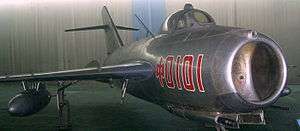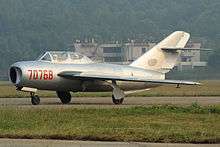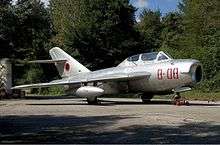Shenyang J-5
| J-5 | |
|---|---|
 | |
| Shenyang J-5 | |
| Role | Fighter aircraft |
| National origin | People's Republic of China |
| Manufacturer | Shenyang Aircraft Corporation[1] |
| First flight | 19 July 1956[1] |
| Introduction | 1956 |
| Retired | 1992 (China) |
| Status | Trainers in service |
| Primary users | People's Liberation Army Air Force (historical) North Korean air force Pakistan Air Force (historical) Vietnam People's Air Force (historical) |
| Number built | 1,820+[1] |
| Developed from | Mikoyan-Gurevich MiG-17 |
The Shenyang J-5 (Chinese: 歼-5) originally designated Dongfeng-101 - (East Wind-101),[1] and also Type 56[1] before being designated J-5 in 1964,[1] is a Chinese-built single-seat jet interceptor and fighter aircraft derived from the Soviet Mikoyan-Gurevich MiG-17.[1] The J-5 was exported as the F-5. The aircraft's NATO reporting name is "Fresco".[2]
The MiG-17 was license-built in China, Poland and East Germany into the 1960s. The People's Liberation Army Air Force (PLAAF) obtained a number of Soviet-built MiG-17 Fresco-A day fighters, designated J-5 in the early 1950s. To introduce modern production methods to Chinese industry the PLAAF obtained plans for the MiG-17F Fresco-C day fighter in 1955, along with two completed pattern aircraft, 15 knockdown kits, and parts for ten aircraft. The first Chinese-built MiG-17F, (serialed Zhong 0101),[1] produced by the Shenyang factory, performed its initial flight on 19 July 1956 with test pilot Wu Keming at the controls.[1]
Plans were obtained in 1961 for the MiG-17PF interceptor and production began, as the J-5A (F-5A),[1] shortly afterwards. At this time the Sino-Soviet split occurred, causing much disruption to industrial and technical projects, so the first J-5A did not fly until 1964, when the type was already obsolete. A total of 767 J-5s and J-5As had been built when production ended in 1969.[1]
The Chinese also built a two-seat trainer version of the MiG-17, designated the Chengdu JJ-5 (Jianjiji Jiaolianji - Fighter Trainer - FT-5),[1] from 1968, by combining the two-seat cockpit of the MiG-15UTI, the VK-1A engine of the J-5, and the fuselage of the J-5A. All internal armament was deleted and a single Nudelman-Richter NR-23 23 mm cannon was carried in a ventral pack. Production of the JJ-5 reached 1,061 when production ceased in 1986, with the type exported to a number of countries.[1]
Operational history


The J-5 and JJ-5 saw widespread use by the PLAAF until supplanted by a more capable aircraft the Chengdu J-7.
Variants
- Type 56 - pre-service designation for the J-5.[1]
- Dongfeng-101 - original service name for the J-5.[1]
- Shenyang J-5 - (Jianjiji-5 - fighter) Chinese production aircraft re-designated in 1964. 767 built, all single seat variants.[1]
- Shenyang J-5A - licence production of the Radar-equipped Mig-17PF. The total production figure for this variant was over 300. J-5As were still in service with PLAAF when J-6A & J-6B were phased out.[1]
- Chengdu JJ-5 - (Jianjiji Jiaolianji - fighter trainer) A twin-seat trainer version of the J-5 designed and developed by Chengdu Aircraft Corporation. Combined the J-5 airframe, J-5A airbrakes and the tandem twin-seat cockpit section of the JJ-2 (MiG-15UTI).[1] Export versions designated FT-5.
- Shenyang J-5 torpedo bomber - A single aircraft modified to carry a single torpedo under the fuselage centreline. Central cannon was removed, as was some fuel storage capacity. Trials showed performance degradation was too great and further work was abandoned.[1]
Operators
Current operators
- People's Liberation Army Air Force — Remaining J-5s converted into suicide drone.
- People's Liberation Army Naval Air Force — Remaining J-5s converted into suicide drone.
- North Korean Air Force — 107 F-5's with another 135 FT-5 trainers remain in service.[3] However, reports of dire levels of serviceability suggest an airworthiness rate of less than 50%.[4]
Former operators
- Albanian Air Force — Shenyang J-5 jets were among the first Chinese military aid to Albania, but the Albanian Air Force's deployment against the Yugoslav air incursion was relatively unsuccessful due to its subsonic speed, and the aircraft were soon reassigned once Shenyang J-6s became available. Remaining J-5s are retired and in storage with the Albanian military.
- Bangladeshi Air Force — All retired in 1980.
- Khmer Air Force — Ten Shenyang J-5 jets were delivered to the then Royal Khmer Aviation (AVRK) in 1965 as military aid. Only six were operational by 1970, only to be lost in January 1971 when the Cambodian Air Force was almost entirely destroyed on the ground by a North Vietnamese Army (NVA) "Sapper" attack.
- Pakistan Air Force — Retired 5 January 2012. PAF's No. 1 Fighter Conversion Unit (FCU) operated 25+ FT-5 trainers from 1975 to 2012, replaced in service by Pakistani-built K-8P Karakorum.[5][6]
- Sri Lankan Air Force — J-5s were used as jet familiarisation trainers for Sri Lankan Air Force pilots.
- Sudanese Air Force — The Sudanese Air Force J-5s have been used for ground attack missions against rebels with limited air defences. Both MiG-17s and J-5s once flew with the Sudanese Air Force.
- Somali Air Corps — like most aircraft in the Somali Air Corps inventory, the majority of the J-5s were lost during the Ogaden War, in which more than 75% of the Somali Air Force was destroyed by the Cuban supported Ethiopian Air Force.
- Tanzanian Air Force — The Tanzanian Air Force used J-5s for ground attack missions during the Uganda-Tanzania War.
- United States Air Force — In the 1980s, the United States purchased a number of J-5 aircraft, along with J-2 aircraft from China via the Combat Core Certification Professionals Company. These aircraft were employed in a "mobile threat test" program at Kirtland Air Force Base, operated by 4477th "Red Hats" Test and Evaluation Squadron of the United States Air Force, and are now believed to be in storage.
- Vietnamese Air Force — The Vietnamese Air Force used J-5s alongside the Soviet supplied MiG-17s for interception missions until the 1990s when they were retired, along with the remaining MiG-19s, being replaced with newer MiG-21s and Su-27s.
- Air Force of Zimbabwe — The J-5s in the Zimbabwe Air Force were first piloted by Pakistani pilots.
Specifications (J-5)
Data from Gordon, Yefim & Komissarov, Dmitry. Chinese Aircraft. Hikoki Publications. Manchester. 2008. ISBN 978-1-902109-04-6
General characteristics
- Crew: (JJ/5 - 2) 1
- Length: (JJ-5 - 11.5 m/37 ft 9 in)(J-5A - 11.36 m/37 ft 4 in) 11.09 m (36 ft 5 in)
- Wingspan: 9.628 m (31 ft 7 in)
- Height: 3.8 m (12 ft 5½ in)
- Wing area: 22.6 m2 (790 ft2)
- Empty weight: (JJ-5 - 4,080 kg / 8,994 lb) (J-5A - 4,151kg / 9,151 lb) n.a. kg (n.a. lb)
- Gross weight: (JJ-5 - 6,215 kg / 13,700 lb) 6,000 kg (13,230 lb)
- Powerplant: 1 × Wopen WP-5, (JJ-5(WP-5D) - 22.27 kN/5,000 lbf) 25.5 kN (5,730 lbf) thrust dry, 33.8 kN (7,452 lbf) with afterburner
Performance
- Maximum speed: @ 5,000 m (JJ-5 - 1,048 km/h / 651 mph)(J-5A - 1,145 km/h/711 mph) 1,130 km/h (702 mph)
- Range: with drop tanks @ 10,000 m (JJ-5 - 1,230 km/764 mi) (J-5A - 1,730 km/1,075 mi) 1,424 km (1,037 miles)
- Service ceiling: (JJ-5 - 14,300 m/46,900 ft) (J-5A - 16,600 m/54,450 ft) 16,500 m (54,000 ft)
- Rate of climb: @ 5,000 m (JJ-5 - 27 m/s/5,315 ft/min) (J-5A - 65 m/s/12,800 ft/min) 65 m/s (12,795 ft/min)
Armament
- 1 x Type 37 37 mm aircraft cannon.
- 2 x Type 23-1 23 mm aircraft cannon.
- (JJ-5 - 1 x Type 23-1 23 mm aircraft cannon)
- (J-5A - 3 x Type 23-1 23 mm aircraft cannon)
See also
Related development
Aircraft of comparable role, configuration and era
Related lists
References
Notes
- 1 2 3 4 5 6 7 8 9 10 11 12 13 14 15 16 17 18 19 Gordon, Yefim & Komissarov, Dmitry. Chinese Aircraft. Hikoki Publications. Manchester. 2008. ISBN 978-1-902109-04-6
- ↑ "Designations of Soviet and Russian Military Aircraft and Missiles". Designation-systems.net. 2008-01-18. Retrieved 2011-11-13.
- ↑ "Flight Global World Air Forces 2014" (PDF). Flight Global. December 2013. Retrieved 13 April 2014.
- ↑ "The AMR Regional Air Force Directory 2012" (PDF). Asian Military Review. February 2012. Retrieved 12 August 2012.
- ↑ "PAF grounds ageing trainer aircraft". Dawn. January 6, 2012. Retrieved June 20, 2013.
- ↑ "Pakistan Air Force retires last FT-5". AirForces Monthly. Key Publishing (289): 32. April 2012. ISSN 0955-7091.
Bibliography
- Taylor, Michael J.H. . “ Jane's Encyclopedia of Aviation. Studio Editions. London. 1989. ISBN 0-517-69186-8
- Gordon, Yefim & Komissarov, Dmitry. Chinese Aircraft. Hikoki Publications. Manchester. 2008. ISBN 978-1-902109-04-6
- http://www.designation-systems.net/non-us/soviet.html#_Listings_Fighter
External links
| Wikimedia Commons has media related to Shenyang J-5. |